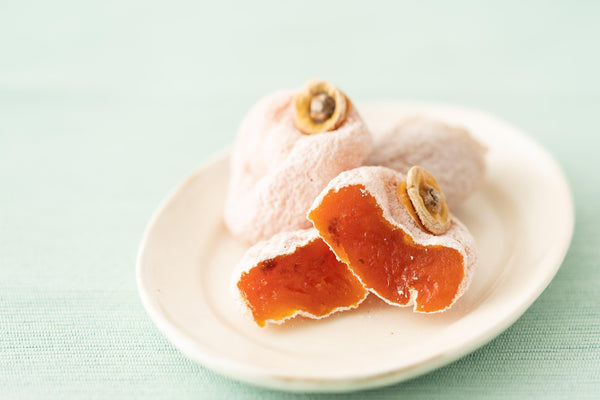A Beginner’s Guide to Hoshigaki – A Healthy Japanese Snack Made from Dried Persimmons

Jump to:
Hoshigaki, or Japanese dried persimmons as we know them in English, are a popular seasonal Japanese snack food made primarily during the autumn months when you can spot persimmon trees laden with their brightly colored orange fruits throughout the country and in supermarkets.
Originally from China, persimmons, known as kaki in Japanese, are commonly found in Japan and Korea and make for a sweet, natural snack in their dried form.
In Japan, hoshigaki are said to bring good luck and are often eaten on New Year’s Day in a custom known as Hagatame in Japanese.
How to make hoshigaki
To make hoshigaki, the dehydrated persimmons are massaged by hand in a labor intense and lengthy process that takes between 4-6 weeks before they are ready to eat as a snack. Although there are hundreds of varieties of persimmons, there are two main categories, astringent and non-astringent, both of which can have quite different tastes.

Astringent persimmons are too firm to eat until they become very ripe and taste extremely bitter before this time. The presence of tannins in these kind of persimmons causes the sharp bitterness, and this category of persimmon is known as hachiya in Japanese. The non-astringent varieties of persimmons are known as fuyu in Japanese and taste sweet even when they are still a little firm. The two categories of persimmons can be easily distinguished by their shape, the hachiya is more pointed in appearance, while the fuyu is rounder, similar in shape to a small pumpkin.
For making hoshigaki, the astringent type of persimmon or hachiya are used. First the tops are cut off the persimmons while still leaving the stem in place, before the skin is peeled. The persimmons are then tied together by the stem with string and hung in sunny windows. In Japan you can often see them hanging outdoors from bamboo poles during the winter months, particularly in rural areas.

The persimmons must be left undisturbed for a week before the daily massaging process begins. This massaging is a delicate process that begins as a light touch before progressing to more of a squeeze. The hoshigaki is ready to eat after a few weeks once a layer of powdery white sugar has formed on the surface and the persimmon becomes a burnt orange color. Once ready to eat, the hoshigaki can be stored for approximately several months in an airtight container or frozen.
Where does Japanese persimmon fruit grow in Japan?
Although persimmon trees are found throughout Japan, there are several regions that specialize in persimmon or kaki production. For example, prefectures to include Yamagata, Niigata, and Nara are all major persimmon growing regions. Other popular Japanese persimmon varieties are found in Fukushima, Yamanashi, and Toyama, whilst the most well-known variety is the Ichida-kaki persimmon found in Nagano prefecture.

The Ichida-kaki or Ichidagaki as it is also known in Japan are said to have a long history. This variety of hoshigaki is produced in the small town of Takamori in Nagano prefecture in an industry that dates back more than 500 years. The area started to become particularly well-known for their hoshigaki during the 1920s when local farmers came up with the name ‘Ichidagaki’ and began selling them around the country in major cities such as Tokyo and Osaka.

Takamori’s geographical location makes for a particularly good place for producing persimmons. Located in a basin formed by the surrounding mountains of the Japanese Alps and close to the Tenryu River makes the temperature and moisture just right for producing hoshigaki. The persimmons are harvested annually around the end of October and in November before the process of turning them into hoshigaki begins.
Nutritional benefits of dried whole persimmons
Persimmons in their original form are rich in fibre, vitamin A, vitamin C, and minerals however they lose most of the vitamin C in the drying process. Although low in fat and completely natural, it’s worth bearing in mind that hoshigaki are quite high in calories at approximately 90-100 calories per serving.
How to eat hoshigaki
Hoshigaki can be eaten on its own as a snack or used in other dishes. When eaten by itself, it is often served with green tea, with the hoshigaki providing a sweet-tasting contrast to the bitter matcha. It can also be used in salads or added into desserts such as cakes and ice cream and is a popular ingredient in wagashi – traditional Japanese sweets.

In recent years hoshigaki has become increasingly popular outside of Japan and is currently fashionable among chefs and millennials, appearing on trendy restaurant menus as well as many Instagram feeds. If you are wondering where to buy Japanese dried persimmons outside of Japan, you can purchase the premium Ichidagaki variety produced in Nagano online here.

Alternatively, if you want to try making your own hoshigaki, you could try taking an online workshop to learn how the drying process works before making them yourself. For example, US-based cooking instructor Sonoko Sakai runs online classes in the autumn where you learn how to pick, peel, hang, and massage the persimmons until they are ready to eat, making for a tasty snack or a unique handmade gift. In addition to Japan, persimmons are grown in several Western countries to include California in the US and southern Europe so why not give it a try!

4 comments
Hi Chuck, thanks for sharing! We hope that you’ll have better luck the next time you eat a persimmon and that it will be just as good as a chocolate persimmon!
Japanese Taste ,
The texture of a raw persimmon is like a hard peach. I have a hybrid persimmon tree which produces chocolate persimmons. A chocolate persimmon is one that has been pollinated. As soon as it develops it is ready to eat and is the sweetest persimmon I have ever eaten. Normally, about 10% of the total fruit on the tree will be chocolate. This year was a bad year. It was quite hot and the fruit ripened before it was mature. We got very few chocolates. You will not find chocolates in the marketplace because it is impossible to tell if it is chocolate until you have cut it open. This year we had close to 500 fruit on the chocolate tree but only about 25 chocolates. I dry the non-pollinated fruit by peeling it and cutting it in quarters and placing the quarters on a cookie cooling sheet with 3/8 " squares. I place them in the sun under a picnic food tent. The white one is best for drying them. It takes about 3 days in the hot late autumn SoCal sun to dry them to where they are sweet to eat. They are not dried in the sense that they are leathery. They are still soft but have turned sweet. You can also sweeten then by freezing them in your refrigerator or by drying them in a food dryer or your oven on its lowest setting. When you dry them in the oven you will see the white tannin running out of the fruit. Time in the oven depends upon how low your lowest setting is. Usually about 4 – 5 hours in my oven.
This afternoon my wife and I shared a fuyu that I purchased at Costco. I think it was picked before it was ripe. It was not as sweet as the fuyu I get off my fuyu tree and not nearly as sweet as the chocolates. It was okay but nothing to rave about.
I have had my kaki trees for about 40 years. It took them almost half that time in order to bear fruit. I have heard that in Japan it is at least 14 years before they bear good fruit in any quantity.
Chuck,
Hi Jenny, hoshigaki are slightly sweeter and are chewier compared to raw persimmons. In particular, the persimmons used for these hoshigaki (Ishida persimmons) are said to have a moderate sweetness and chewy texture, yet melt in your mouth as soon as you take a bite.
Japanese Taste ,
Thank you for the great information! I’m sorry if I missed this, but what do they taste like, in comparison to a raw persimmon?
Jenny,